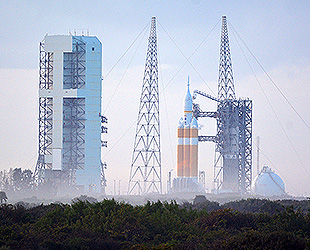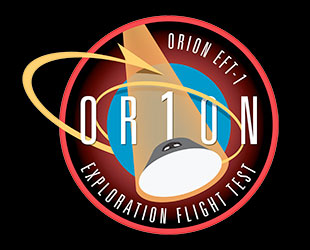Dec. 4, 2014 – NASA's first Orion spacecraft experienced its first launch scrub on Thursday (Dec. 4) due to an issue with closing valves inside the prototype capsule's massive ride to orbit.
United Launch Alliance flight controllers, who oversaw the countdown to NASA's and Lockheed Martin's Exploration Flight Test-1 (EFT-1), the first test flight of an Orion atop a Delta 4 Heavy rocket, called for at least a 24-hour delay to troubleshoot the propellant fill-and-drain valves inside two of the launch vehicle's three "common core" boosters.
"The team worked really hard and made a great attempt to get off today," Mark Geyer, the manager of NASA's Orion program, said in a press conference. "In the end, we made the right choice, given the data we had, to not fly today."
"We'll attempt tomorrow," Geyer added. "There's still some open work, but our plan is to fly tomorrow."
The scrub was called ten minutes before the close of the EFT-1 mission's first two-hour, 39-minute launch window. United Launch Alliance, NASA and Lockheed Martin had targeted the liftoff for the start of the window at 7:05 a.m. EST (1205 GMT) Thursday from Complex 37 at the Cape Canaveral Air Force Station in Florida.

The Exploration Flight Test-1 Delta 4 Heavy and Orion capsule as seen just before the launch scrubbed on Dec. 4. (collectSPACE) |
Then the problems began.
The countdown was first halted to address a range safety concern with a boat that was believed to have strayed into the launch danger zone off the eastern coast of Florida, as well as a need for more time to condition the propellant for the Delta 4 Heavy's cryogenic second stage. A new liftoff time was set for 7:17 a.m. EST (1217 GMT).
The clock was halted again at 7:14 a.m. EST, this time as a result of strong winds near the ground posting a threat to the rocket's ascent. A new launch ("T-zero') time was set for 7:55 a.m., but winds fouled that attempt too, pushing the liftoff of the Orion space capsule another half hour.
"As the rocket lifts off, a wind can push the rocket," Dan Collins, chief operating officer for United Launch Alliance, said in the press conference. "You look at the sail area of a [Delta 4] Heavy and wind from certain direction... which side of the rocket that wind is blowing on, it's kind of either blowing on a knife or blowing on a garage door."
All looked good for an 8:26 a.m. start time for the EFT-1 mission when, three minutes prior to the planned launch, another hold was called. The hydrogen fill and drain valves in the Delta 4's left and center common core boosters did not close when commanded.
"Shortly after we pick up the terminal count, these valves close and then never operate again," Collins said. "They're there while we are filling the tanks but once they are full, they stay static for the entire rest of the mission."

NASA's Orion Exploration Flight Test-1 (EFT-1) insignia. (NASA) |
Attempts to troubleshoot, including cycling the valves five times as had worked on a previous flight when that rocket experienced a similar issue, did not resolve the problem. The teams also tried pressurizing the tanks and changing the propellant fill rate to "jostle" the valves closed.
Ultimately, the launch window came to a close before the valves could be shut, resulting in the scrub being called at 9:34 a.m. EST (1434 GMT). Pending the valves' problem being resolved, the EFT-1 liftoff has been rescheduled for 7:05 a.m. EST on Friday. The forecasts however, call for just 40 percent chance of the weather being acceptable at launch time, down from 70 percent on Thursday.
"While the percentage is higher [than Thursday's forecast], the wind direction is actually better for us," Geyer said.
When it does launch, NASA's and Lockheed Martin's EFT-1 mission will send the uncrewed Orion capsule 14 times farther out than the International Space Station on a four-and-a-half-hour flight to test out its heat shield and other systems needed for future astronaut-crewed missions into deep space. After circling the planet twice, the Orion will re-enter the atmosphere at 20,000 miles per hour (32,200 kph) before descending under parachutes to splash down in the Pacific Ocean.
